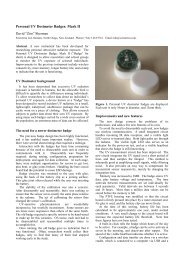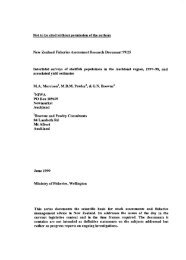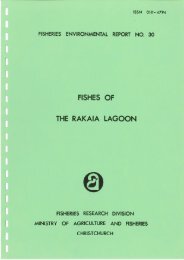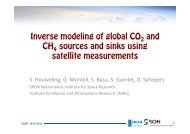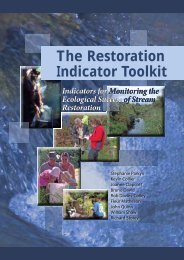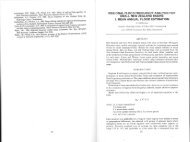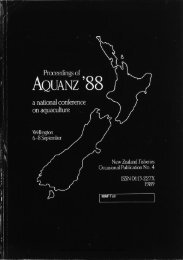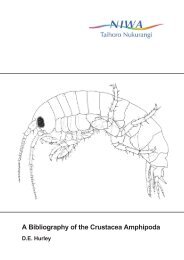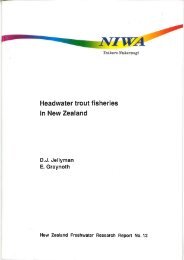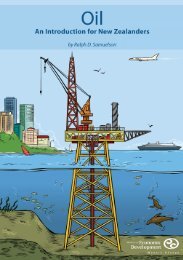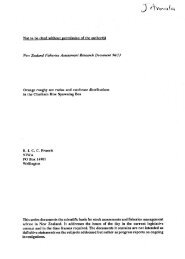WATER & SOIL - These are not the droids you are looking for.
WATER & SOIL - These are not the droids you are looking for.
WATER & SOIL - These are not the droids you are looking for.
You also want an ePaper? Increase the reach of your titles
YUMPU automatically turns print PDFs into web optimized ePapers that Google loves.
Appendix F<br />
Flood frequency analysis <strong>for</strong> Otago and<br />
Southland<br />
F.1 lntroduction<br />
At <strong>the</strong> time of developing <strong>the</strong> flood frequency curves <strong>for</strong><br />
<strong>the</strong> eight regions covering New Zealand, <strong>the</strong>re were only six<br />
relatively short flood records available <strong>for</strong> <strong>the</strong><br />
Otago/Southland region. This region's flood frequency<br />
curve was <strong>the</strong>re<strong>for</strong>e treated as provisional and was only extended<br />
to <strong>the</strong> 100-year return period; <strong>for</strong> <strong>the</strong> o<strong>the</strong>r regions<br />
<strong>the</strong> curves were drawn up to 200 years. The tentative nature<br />
of <strong>the</strong> analysis is best illustrated by <strong>the</strong> fact that one of <strong>the</strong><br />
records used was <strong>for</strong> <strong>the</strong> Pomahaka River at Burkes Ford<br />
(Station 75232) <strong>for</strong> <strong>the</strong> period 1963-1975. The flood peak<br />
<strong>for</strong> 1972 of 1088 mtls was omitted because it appe<strong>are</strong>d to<br />
be an extreme outlier, yet this peak has been exceeded three<br />
times over <strong>the</strong> period 1978-1980.<br />
The number of <strong>not</strong>ably large floods in <strong>the</strong> <strong>are</strong>a in <strong>the</strong><br />
period 1978-1980, and <strong>the</strong> availability of substantially more<br />
data, suggested that reassessment of flood frequencies in<br />
this <strong>are</strong>a was appropriate. This appendix gives <strong>the</strong> results<br />
of <strong>the</strong> reassessment, which has been completed just in time<br />
to be published as a supplement to <strong>the</strong> main study.<br />
F.2 Data collection<br />
With assistance of staff of <strong>the</strong> Otago and Southland Catchment<br />
Boards, annual maximum flows <strong>for</strong> stations with at<br />
least l0 years of reliable flow record were extracted. The<br />
catchments <strong>are</strong> listed in Table F.l and <strong>the</strong>ir locations <strong>are</strong><br />
indicated in Figure F.l. The flood peak data <strong>are</strong> given in<br />
Table F.2.<br />
Additional historical data were sought. <strong>These</strong> data took<br />
two <strong>for</strong>ms. The first was estimates of large floods which<br />
occurred be<strong>for</strong>e recording commenced and which were <strong>the</strong><br />
largest <strong>for</strong> a known period. For example, <strong>the</strong> estimated<br />
p"it of 220 m3/s in tÈe Leith on 19-20 March 192í is <strong>the</strong><br />
largest known in this <strong>are</strong>a since settlement, which is taken<br />
as dating from 1850. The second <strong>for</strong>m was when <strong>the</strong> largest<br />
recorded flood was also <strong>the</strong> largest known peak in a<br />
preceding interval. For example, <strong>the</strong> peak of 505 m',/s<br />
recorded on <strong>the</strong> Mak<strong>are</strong>wa River on 15 October 1978 is<br />
known <strong>not</strong> to have been exceeded since 1895.<br />
Sources of historical in<strong>for</strong>mation <strong>are</strong> "Hydrology Annuals"<br />
No. 3 No. 17 published by <strong>the</strong> Ministry of Works<br />
(1955-1969), and<br />
-<br />
"Floods in New Zealand (1920-1953)"<br />
published by <strong>the</strong> Soil Conservaton and Rivers Control<br />
Council (1957), supplemented by in<strong>for</strong>mation from catchment<br />
boa¡ds and some early newspaper reports. As early<br />
historical estimates <strong>are</strong> of uncertain accuracy, only data<br />
considered to be reliable were used.<br />
Annual maximum l2-hr duration lake inflows calculated<br />
from records of levels and outflows (Gilbert 1978) <strong>for</strong><br />
Hawea, Wanaka, Wakatipu and Te Anau were used. Local<br />
inflows to Manapouri were <strong>not</strong> used because <strong>the</strong>y <strong>are</strong><br />
calculated as Manapouri outflow, minus inflow from Te<br />
Anau, minus change in lake storage, and since inflow from<br />
Te Anau is 6690 of Manapouri outflow <strong>the</strong> residual local<br />
inflow is subject to large errors. Although <strong>the</strong> l2-hr maxima<br />
inflows <strong>are</strong> less than instantaneous maxima, <strong>the</strong><br />
reasonable assumption that <strong>the</strong> instantaneous maxima <strong>are</strong><br />
a constant ratio (say 1.2) of <strong>the</strong> l2-hr maxima suggests<br />
<strong>the</strong>se data can usefully supplement <strong>the</strong> maxima recorded on<br />
rivers <strong>for</strong> frequency analysis purposes.<br />
Flow records were also derived <strong>for</strong> two contributing<br />
<strong>are</strong>as in large catchments by subtracting, from downstream<br />
flows, <strong>the</strong> upstream flows lagged to allow <strong>for</strong> time of<br />
travel, Records of annual maxima were thus derived <strong>for</strong> <strong>the</strong><br />
Waiau River between Tuatapere and <strong>the</strong> Mararoa confluence,<br />
and <strong>the</strong> Clutha River between Clyde and <strong>the</strong><br />
Shotover and <strong>the</strong> three lakes. Because <strong>the</strong>se data <strong>are</strong> derived<br />
by differencing hydrographs, after making assumptions<br />
about <strong>the</strong> travel times of <strong>the</strong> upstream hydrograph, <strong>the</strong> errors<br />
in <strong>the</strong> estimated peaks <strong>are</strong> significantly greater than <strong>for</strong><br />
o<strong>the</strong>r records. They were <strong>the</strong>re<strong>for</strong>e <strong>not</strong> used in deriving <strong>the</strong><br />
regional curves; however, <strong>the</strong>y provide a useful independent<br />
check on <strong>the</strong> curves derived from <strong>the</strong> o<strong>the</strong>r data.<br />
Table F.1 L¡st of catchments.<br />
Number of<br />
Stat¡on<br />
Catchment number<br />
in Fig. 1<br />
Name of River and Recording Station<br />
Year<br />
Record<br />
starts<br />
Catchment<br />
atea<br />
(km2l<br />
1<br />
2<br />
3<br />
4<br />
5<br />
6<br />
7<br />
I I<br />
10<br />
11<br />
12<br />
13<br />
14<br />
15<br />
16<br />
17<br />
18<br />
19<br />
20<br />
21<br />
22<br />
73501<br />
74308<br />
74310<br />
74314<br />
74346<br />
75259<br />
75232<br />
77504<br />
77505<br />
7A502<br />
78607<br />
78625<br />
78633<br />
78803<br />
78906<br />
75276<br />
75253<br />
23<br />
24 84701<br />
Water of Le¡th at University Footbridge<br />
Taieri at Outram<br />
Taier¡ at Sutton<br />
Taieri at Patearoa-Paerau Bridge<br />
Loganburn at Paerau<br />
Fraser at Old Man Range<br />
Pomahaka at Burkes Ford<br />
Mataura at Gore<br />
Mataura at Parawa<br />
Waihopai at Kennington<br />
Oreti at Lumsden<br />
Otap¡ri at McBridges Bridge<br />
Mak<strong>are</strong>wa at Freezing Works Bridge<br />
Middle Creek at Otahuti<br />
Aparima at Dunrobin<br />
Lake Wakatipu inflow<br />
Lake Wanaka inflow<br />
Lake Hawea inflow<br />
Lake Te Anau inflow<br />
Shotover at Bowens Peak<br />
Manuherikia at Ophir<br />
1 964<br />
1 955<br />
1 961<br />
1 968<br />
1 967<br />
1 969<br />
1 962<br />
1 957<br />
1 956<br />
1 958<br />
1 957<br />
1 963<br />
1 955<br />
1 970<br />
1 963<br />
1927<br />
1 930<br />
1 931<br />
1 926<br />
1 968<br />
197 1<br />
Clutha tributaries above Clyde, and below<br />
Shotover and <strong>the</strong> lake outflows (see McKerchar,<br />
1981. Table 4.1) 1963<br />
Waiau tributa¡ies above Tuatapere and below<br />
Mararoa. {see McKerchar, 1981, Table 4.1} 1969<br />
Cleddau at M¡l<strong>for</strong>d 1964<br />
45<br />
4 705<br />
3 066<br />
738<br />
150<br />
122<br />
1 924<br />
3 465<br />
766<br />
152<br />
1 160<br />
108<br />
1 040<br />
27<br />
215<br />
3 133<br />
2 624<br />
1 384<br />
3 124<br />
1 088<br />
2 036<br />
3 839<br />
2 336<br />
155<br />
Water & soil technical publication no. 20 (1982)<br />
t23



